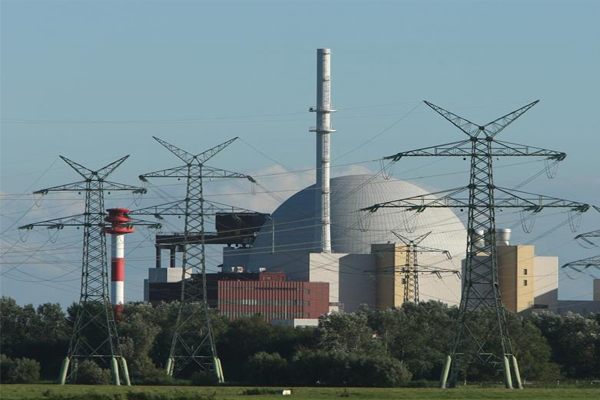It has been a chaotic year in the energy sector. And with just a few hours left in 2021, I put together my list of the mos
t important energy developments of the year. It’s a personal list and not meant to be comprehensive. So without further ado,
my top seven stories of the year.

nuclear power plants including this one, the Brokdorf nuclear plant near Hamburg.
(Photo by Sean Gallup/Getty Images)
The Texas Blackouts Demonstrate the Foolishness of the “Electrify Everything” Push. This story is first because it’s personal. On February 15, our home in central Austin was blacked out. Our power stayed off for 45 hours. The post-mortem of the blackouts has been ugly. Yes, some natural gas supplies were unavailable due to the cold weather. But the reality is that some $66 billion was spent on wind and solar projects in Texas in the years before the blackout and yet when the ERCOT grid was on the verge of collapse, effectively none of that renewable capacity was producing power. State regulators are still wrestling with how to assure blackouts don’t happen again this winter. But it is clear that the Texas grid is not as robust as it should be and it is being fragilized by the addition of too much renewable capacity and not enough thermal capacity.
Texas is only part of the story. As I wrote during the power outage, “This blizzard proves that attempting to electrify everything would be the opposite of anti-fragile. Rather than make our networks and critical systems more resilient and less vulnerable to disruptions caused by extreme weather, bad actors, falling trees, or simple negligence, electrifying everything would concentrate our dependence on a single network, the electric grid, and in doing so make nearly every aspect of our society prone to catastrophic failure if — or rather, when — a widespread or extended blackout occurs.”
Coal Comes Roaring Back. A few years ago, I debated Jigar Shah, a solar-energy promoter and founder of SunEdison, who now directs the loan programs office at the Department of Energy. Shah contended that coal was dead and that solar was going to take over the world. Yes, well. Solar has grown over the past few years. But coal, the fuel that Thomas Edison used on Pearl Street and that climate activists have disparaged for years, keeps on keeping on. Earlier this month, the International Energy Agency reported that “global coal power generation is on course to increase by 9% in 2021 to 10,350 terawatt-hours (TWh) – a new all-time high.” The agency also reported that “coal demand may well hit a new all-time high in the next two years.”
According to the IEA, three factors are driving the surge in coal use: the quick post-pandemic rebound in the global economy, a cold winter followed by a hot summer, and weather conditions that pushed natural gas “prices to all-time highs, raising demand for coal for power generation.” While those factors are driving coal demand, the continuing use of the carbon-heavy fuel proves yet again, what I call the Iron Law of Electricity, which says “People, businesses, and countries will do whatever they have to do to get the electricity they need.” Love coal or hate it, it’s going to stick around for a long time to come. MORE FROMFORBES ADVISORBest Travel Insurance CompaniesByAmy DaniseEditorBest Covid-19 Travel Insurance PlansByAmy DaniseEditor
Solar Sector’s Dependence on Uyghur Slave Labor Gets Exposed. So much for all the hype about “clean” power. After all, how much slave labor is okay when it comes to supplying the polysilicon needed to produce PV panels? That question has the solar sector squirming like never before. Nearly half of the world’s polysilicon, the key ingredient in solar panels, has been coming from Xinjiang province, where the Chinese government has launched a program of systematic repression and forced labor. In June, the US government announced it would restrict imports from the province. Al Jazeera reported that the restrictions were focused on “five Chinese companies that it said were implicated in Chinese human rights violations, including large producers of polysilicon for the solar panel industry. The companies were listed over human rights violations and abuses of Uighurs and other Muslim minorities, according to a US government filing on Wednesday. The US Department of Commerce said the firms are accepting or utilizing forced labor.”

It appears the government was forced to act after a scathing report was published in May by Laura T. Murphy and Nyrola Elima, of Helena Kennedy Centre for International Justice at Sheffield Hallam University, titled “In Broad Daylight: Uyghur Forced Labour and Global Solar Supply Chains.” The report found that in 2020, about 45% of the world’s polysilicon came from the Uyghur area of Xinjiang where some 2.6 million Uyghur and Kazakh citizens have been placed “in jobs in farms and factories within the Uyghur Region and across the country through these state-sponsored ‘surplus labour’ and ‘labour transfer’ initiatives.” Murphy and Elima continued, explaining that “significant evidence – largely drawn from government and corporate sources – reveals that labour transfers are deployed in the Uyghur Region within an environment of unprecedented coercion, undergirded by the constant threat of re-education and internment. Many indigenous workers are unable to refuse or walk away from these jobs, and thus, the programmes are tantamount to forcible transfer of populations and enslavement.”
Give credit where it is due: author and activist Michael Shellenberger wrote about the problem of Uyghur slave labor in these pages in April, before Murphy and Elima’s report was published. To my knowledge, he was the first to use the term “Chinese genocide solar panels,” which he used on the Power Hungry Podcast in May.
It’s not clear if that label will stick or how the solar sector will recover from the sanctions on Xinjiang polysilicon. Whatever happens next, the notion that solar is “clean” energy has definitely been tarnished. (Full disclosure: I have 8.5 kilowatts of solar panels on my roof. My panels were made in South Korea. Do they contain polysilicon from China? I don’t know.)
Europe’s Energy Suicide. Earlier this year, on the Power Hungry Podcast, oil analyst Art Berman said something that stuck in my head: “Energy is the economy.” That truth is being played out right now in Europe, where natural gas and electricity prices are skyrocketing, industries are shutting down factories, and energy poverty looms for millions of residents. Last month, during my testimony before the Senate Energy and Natural Resources Committee, I explained that the reasons for Europe’s energy meltdown are obvious: underinvestment in hydrocarbon production, overinvestment in weather-dependent renewables, premature shuttering of its coal and nuclear power plants, and overdependence on imported natural gas, particularly from Russia. Those factors I explained, have made Europe “vulnerable to dramatic prices swings and potentially long-term supply shortages. The implications of Europe’s price spikes include soaring inflation, deindustrialization, and increasing energy burdens on consumers, especially the working poor. The knock-on effects could last for months, or even years.”
Numerous news outlets have documented Europe’s predicament, which is being exacerbated by an ongoing wind drought and unpredictable flows of gas from Russia. On December 22, Reuters reported that “In Germany, Europe’s largest economy with the continent’s highest wind power capacity, combined output from both on and offshore wind farms fell around 16% this year-to-date.” The lack of wind generation in Germany and other European countries led to more reliance on natural gas, which depleted supplies at the same time Russia has been using more natural gas for internal markets and sending less gas to Europe. On Wednesday, Zoltan Ban published a sharp piece on Seeking Alpha in which he warned that Europe’s energy crisis “is set to become permanent, which will devastate its economy. Europe’s petrochemical industry is likely to be the first victim.”
Nuclear Plant Closures in Germany and New York. Today, Germany is closing three of its six remaining nuclear power plants. It is doing so despite Germany’s pledge to slash its greenhouse gas emissions and be “climate neutral” by 2045. Germany plans to shut down the remaining three nuclear plants at the end of 2022.
The German closures follow on the heels of the April closure of the last operating reactor at the Indian Point Energy Center in Buchanan, New York. As I wrote in these pages in April, “the premature closure of the Indian Point Energy Center…should make anyone who cares about climate change, electricity prices, or the security of the electric grid even more cynical about our politicians and the ‘green’ groups who insist we must take urgent action to slash, or eliminate our greenhouse gas emissions. Indeed, cynicism, and lots of it, is the sensible response to the closure of Indian Point because it will result in dramatic increases in New York’s greenhouse gas emissions at roughly the same moment that New York Gov. Andrew Cuomo, New York City Mayor Bill de Blasio, climate activists, and top officials in the Biden administration are claiming that we need to quit using hydrocarbons. Just last week, Biden declared his intent to cut America’s greenhouse gas emissions by 50% in just nine years.” Since the closure of Indian Point, the electricity it was producing has – as was widely predicted — been replaced by natural gas-fired power plants, and New York’s electric-sector emissions increased by a whopping 37%.
The closures of the nuclear plants in Germany and New York are terrible public policy and even worse climate policy. As I explained in April, if we are facing an “existential crisis” due to climate change, then keeping all existing reactors open and operating is the “equivalent of a layup in basketball or a 3-inch putt in golf.” By closing them, Germany and New York are, in soccer terms, committing an own goal. In football, it’s akin to Leon Lett fumbling the ball in the endzone.

The Energy Cluelessness of the Biden Administration. There is no sugarcoating this fact: the Biden administration is the most anti-hydrocarbon administration in American history. Whether it was the first-day cancellation of the Keystone XL pipeline or the next-day restrictions on leasing of federal lands and waters for drilling, the Bidenistas have made it clear they don’t like coal, oil, or natural gas. Furthermore, Energy Secretary Jennifer Granholm may be the least-informed, least-prepared person to ever hold that office. In March, Granholm told the attendees at the CERAWeek conference in Houston that “We have to add hundreds of gigawatts to the grid over the next four years. It’s a huge amount. And there’s so little time.”
There’s so much ignorance in those three sentences that it’s difficult to fathom why Granholm was ever selected to head the Energy Department. Granholm, and her staff, should know that the total installed electric generating capacity in the US is about 1,100 gigawatts or 1.1 million megawatts. To claim that the US should add “hundreds of gigawatts” to the grid, and do so in just four years, is nonsense on stilts. Further, this is the same Granholm who, last month, couldn’t answer the question about how many barrels of oil the U.S. consumes.
The Backlash Against Big Wind and Big Solar Gains Momentum. Rasheed Wallace, the volatile former power forward with the Detroit Pistons and other NBA teams, and now an assistant coach at the University of Memphis, coined the catchphrase: “Ball don’t lie.” If Wallace or one of his teammates was called for a foul during a basketball game that he thought was undeserved, and the opposing player missed the ensuing free throws, Wallace would often holler, “ball don’t lie,” as if the basketball itself was pronouncing judgment on the referee’s errant call.
When it comes to the expansion of wind and solar, the numbers don’t lie. As I noted in these pages earlier this year, more than 300 local communities from Maine to Hawaii have rejected or restricted wind projects over the past six years. The backlash against Big Solar is also gaining momentum. Over the summer, Big Solar projects in Pennsylvania, Nevada, and Montanawere rejected. In Wisconsin, local residents in Dane County are fighting the proposed 300-megawatt Koshkonong Solar Center, which is being promoted by Chicago-based Invenergy, one of the world’s largest privately held renewable-energy developers. In Virginia, a group called Citizens for Responsible Solar is fighting three large projects that aim to pave thousands of acres near the town of Culpeper with solar panels. Among the most recent rejections of Big Solar was the unanimous vote last month in Virginia by the Henry County Board of Zoning Appeals to reject two large proposed solar projects. Of course, the rural backlash against Big Wind and Big Solar doesn’t get much coverage from big media outlets. But the backlash is real and it is growing. Land-use conflicts are the binding constraint on the growth of renewables and the friction over the siting of Big Wind and Big Solar projects will only grow in the years ahead.
Okay, that’s it. Happy New Year, y’all.Follow me on Twitter or LinkedIn. Check out my website or some of my other work here. Robert BryceFollow
Robert Bryce is an author, journalist, filmmaker, and the host of the Power Hungry Podcast. He has been writing about energy, power, innovation, and politics for more than three decades. Bryce has authored six books in which he has covered Enron’s bankruptcy, corn ethanol, digital drilling rigs, renewables, batteries, nuclear energy, and the future of the electric grid. His latest book, A Question of Power: Electricity and the Wealth of Nations, was published in 2020. His articles have appeared in numerous publications including the Wall Street Journal, New York Times, New York Post, and Sydney Morning Herald. His feature-length documentary, Juice: How Electricity Explains the World, is available on iTunes, Amazon Prime, and myriad other streaming services. He lives in Austin, Texas, with his wife, Lorin, who is an art teacher, photographer, and master potter.
Follow Bryce on Twitter: @pwrhungry.
By Robert Bryce – Forbes
forbes.com 12 31 2001












